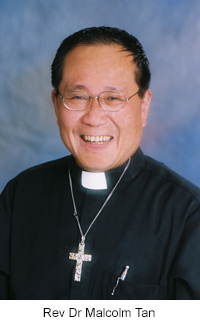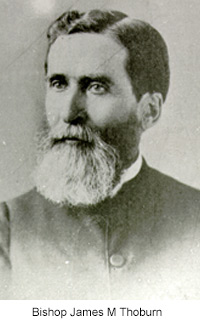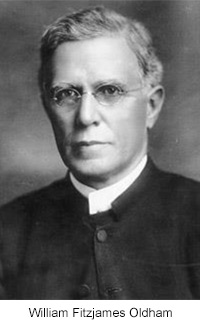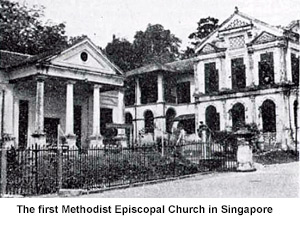|
 Methodism came to Singapore
from the Methodist Episcopal
Church (MEC)’s South India
Annual Conference, February
1885. The earliest Missionaries
were James Thoburn and
William Oldham. Arriving
at the Harbour they were
unexpectedly met by Charles
Phillips, a pious English
Wesleyan living in Singapore,
who somehow anticipated their
coming that morning. Thoburn
decided to conduct evangelistic
gatherings immediately. The
Singapore Conference Hall
was secured for nightly meetings. Thoburn preached the
first Methodist sermon in Singapore from Zechariah 4:6, ‘Not
by Might, nor by Power but by My Spirit, says the LORD.’
He told the people that by the Power of the Holy Spirit, they
would experience Jesus Christ, flee from sin and turn to God,
finding new life. These meetings continued nightly for three
weeks. Some who responded, became early members of the
Methodist Church. Things happened fast. The Missionaries
arrived, 7 February; the first night of the evangelistic meetings
was 8 February; the first Methodist Quarterly Conference
was organised on 23 February with Oldham as Pastor of 26
members and probationers; Dr Thoburn and his party left for
India by 25 February 1885. Before leaving, Thoburn charged
Oldham: ‘Methodism appoints you as herald to a nation and
there must be a continual overflow to your activities, which will
never end until you overtake all Malaysia.’ Thoburn imparted
Vision to Oldham but he did not give a plan. Oldham was to learn
to trust God. In fact, Thoburn confided with his wife as their ship
left harbour: ‘God forgive me if I envy Oldham.’ Earlier, Thoburn
said of Oldham in his Journal, 11 February 1885: ‘Dear brother
Oldham will have a hard trial of his faith here, but……God will
sustain him.’ At the harbour, Oldham turned and asked Charles
Phillips as they watched Thoburn sail away: ‘What next?’ To
which Charles Phillips replied: ‘As God wills.’ Methodism came to Singapore
from the Methodist Episcopal
Church (MEC)’s South India
Annual Conference, February
1885. The earliest Missionaries
were James Thoburn and
William Oldham. Arriving
at the Harbour they were
unexpectedly met by Charles
Phillips, a pious English
Wesleyan living in Singapore,
who somehow anticipated their
coming that morning. Thoburn
decided to conduct evangelistic
gatherings immediately. The
Singapore Conference Hall
was secured for nightly meetings. Thoburn preached the
first Methodist sermon in Singapore from Zechariah 4:6, ‘Not
by Might, nor by Power but by My Spirit, says the LORD.’
He told the people that by the Power of the Holy Spirit, they
would experience Jesus Christ, flee from sin and turn to God,
finding new life. These meetings continued nightly for three
weeks. Some who responded, became early members of the
Methodist Church. Things happened fast. The Missionaries
arrived, 7 February; the first night of the evangelistic meetings
was 8 February; the first Methodist Quarterly Conference
was organised on 23 February with Oldham as Pastor of 26
members and probationers; Dr Thoburn and his party left for
India by 25 February 1885. Before leaving, Thoburn charged
Oldham: ‘Methodism appoints you as herald to a nation and
there must be a continual overflow to your activities, which will
never end until you overtake all Malaysia.’ Thoburn imparted
Vision to Oldham but he did not give a plan. Oldham was to learn
to trust God. In fact, Thoburn confided with his wife as their ship
left harbour: ‘God forgive me if I envy Oldham.’ Earlier, Thoburn
said of Oldham in his Journal, 11 February 1885: ‘Dear brother
Oldham will have a hard trial of his faith here, but……God will
sustain him.’ At the harbour, Oldham turned and asked Charles
Phillips as they watched Thoburn sail away: ‘What next?’ To
which Charles Phillips replied: ‘As God wills.’
 Oldham was faithful to the charge given. He held meetings at
the Christian Institute building belonging to Charles Phillips at
the corner of Middle Road and Waterloo Street. There, he built
up his earliest congregation comprising of local enquirers from
his frequent street preaching. He also brought in British soldiers
as he was ‘Wesleyan Chaplain’ to the Barracks. The Methodists
grew steadily and incrementally with whatever resources
available. It wasn’t until 1894 that the Malaysia Mission,
received regular financial support from the MEC Missionary
Society in New York. This was after Thoburn became Missionary
Bishop at the MEC General Conference (1888). Before that,
fundraising was a regular practice, depending greatly on John
Polglase, Assistant Secretary of the Singapore Municipality
and a newly recruited church member. Polglase headed the
first Official Board and later, became a licensed Local Preacher. Oldham was faithful to the charge given. He held meetings at
the Christian Institute building belonging to Charles Phillips at
the corner of Middle Road and Waterloo Street. There, he built
up his earliest congregation comprising of local enquirers from
his frequent street preaching. He also brought in British soldiers
as he was ‘Wesleyan Chaplain’ to the Barracks. The Methodists
grew steadily and incrementally with whatever resources
available. It wasn’t until 1894 that the Malaysia Mission,
received regular financial support from the MEC Missionary
Society in New York. This was after Thoburn became Missionary
Bishop at the MEC General Conference (1888). Before that,
fundraising was a regular practice, depending greatly on John
Polglase, Assistant Secretary of the Singapore Municipality
and a newly recruited church member. Polglase headed the
first Official Board and later, became a licensed Local Preacher.
Not long after February 1885, Oldham was walking down the
street with a recent Chinese convert. They came across a
building with a sign: ‘The Celestial Reasoning Association’. (It
was founded earlier in
1882). Oldham asked his
young companion about
it. He was told that it was a
society seeking to master
the English language for
purposes of debate. Its
members were Chinese
merchants having to deal
with the British colonial
authorities in Singapore.
Oldham asked if he
could join. His offer was
turned down. He was
invited instead to come
for a dinner and to give a
lecture on a subject of his
choice. Oldham gladly
accepted the invitation
and offered to lecture on
‘Astronomy’.
Thirty Chinese merchants
and the Chinese Consul
General were present
when Oldham was
brought grandly for dinner
by carriage and gave his
 lecture. The next morning,
Oldham promptly
received a letter asking
if he could be a tutor in
English to a member of
the legislative council of
Singapore (Tan Keong
Saik) who was earlier
present at dinner. Oldham agreed and eventually, many more
generous offers were made to him by other wealthy merchants.
The new opportunities suddenly available, made Oldham think
about his purpose: He came to Singapore to be a Missionary and
not an English tutor to wealthy merchants. Hence, his counter
offer: That he would teach their sons instead, by opening a School
for them. The earliest publicity handbill read thus: lecture. The next morning,
Oldham promptly
received a letter asking
if he could be a tutor in
English to a member of
the legislative council of
Singapore (Tan Keong
Saik) who was earlier
present at dinner. Oldham agreed and eventually, many more
generous offers were made to him by other wealthy merchants.
The new opportunities suddenly available, made Oldham think
about his purpose: He came to Singapore to be a Missionary and
not an English tutor to wealthy merchants. Hence, his counter
offer: That he would teach their sons instead, by opening a School
for them. The earliest publicity handbill read thus:
“The Anglo-Chinese School is to be opened in Amoy
Street, No.70. on 1st March 1886. Chinese will be taught
from 8am to 12pm and English from 1.30pm to 4pm.
Apply to the superintendent, W.F Oldham, care of Lim
Kong Wan and son, 21, Malacca Street.”
The School started with 13 boys on 1st March 1886 at Amoy
Street. Within a week, 36 students were enrolled with many
more coming. Later, the need came to purchase a $12,000.00
building for the boarding school of ACS, at nearby Orchard
Road, which was occupied in 1891. Oldham approached his
new local financial backer friends, who counter offered, that
they would cover half the amount if he could find the other
half. Oldham turned to the MEC Missionary Society in New
York for help. The Secretary, Charles Cardwell McCabe known
as a fundraiser and Missions promoter, responded to Oldham
with a promise to ‘find the $6,000.00’. Within three weeks,
a local merchant (Tan Jiak Kim) presented Oldham with a
$6,300.00 cheque, asking about the other half. Oldham wrote
to C.C. McCabe who promptly sent a $6,000.00 cheque with
a message: ‘Tell your China men that they are too swift for us
and we do not propose to take any more of their dares.’ This
episode, however, strengthened Oldham’s relationship with the
local community, gaining their trust. Clearly, the Mission School
was the primary strategy for Methodism in Singapore and the
Malay Peninsula. To quote Oldham:
“The school grew. Meanwhile we were preaching in
English, in Tamil and in several dialects of Chinese and
it seemed as though Thoburn’s instructions to become
a herald to the nation was beginning to be fulfilled……
the story of Methodism in Malaysia begins to be a story
of educational occupation accompanied as every true
education must be with the effort to evangelise……”
Later, before his departure (June 1889) from Singapore, due to
ill-health, Oldham had this to say about the first Mission School
that he founded, i.e. The Anglo-Chinese School (ACS):
“The influence of this School is very marked. Nothing like it has
ever been seen here and we find that our school work opens
our way in every other direction. Merchants and officials are
astonished to see how influential we are in Chinese circles, the
children of nearly all the leading China men of this port are in
our school. Those lads are now receiving definite instructions.
Several of them are deeply affected. Two have been definitely
converted. I gain access to men I could never dream of reaching
otherwise. I have no hesitation in saying this is a Divinely
created agency of marked power.”
 Meanwhile, Oldham’s congregation had grown sufficiently to
move from Middle Road, into a new and larger Sanctuary at
Coleman Street, on December 1886, just ten months after
the founding of the Anglo-Chinese School: it was the first
Methodist Episcopal Church in Singapore. The school, soon,
moved into a new building next to the Church. From the school,
came converts and congregation members, as well as, local
financial support for the early years, producing a new season
of accelerated growth. ‘The school pays. Without this school
we would have been without a Mission’, said R. W. Munson,
in 1890. Munson was a Methodist Missionary in Singapore,
working as a teacher in ACS and later, Principal. 2020 marks the
135th Anniversary of Methodism in Singapore. 1st March, 2021
will mark the 135th Anniversary of the ACS family of schools in
Singapore. To God be the Glory! The Best is yet to Be! Meanwhile, Oldham’s congregation had grown sufficiently to
move from Middle Road, into a new and larger Sanctuary at
Coleman Street, on December 1886, just ten months after
the founding of the Anglo-Chinese School: it was the first
Methodist Episcopal Church in Singapore. The school, soon,
moved into a new building next to the Church. From the school,
came converts and congregation members, as well as, local
financial support for the early years, producing a new season
of accelerated growth. ‘The school pays. Without this school
we would have been without a Mission’, said R. W. Munson,
in 1890. Munson was a Methodist Missionary in Singapore,
working as a teacher in ACS and later, Principal. 2020 marks the
135th Anniversary of Methodism in Singapore. 1st March, 2021
will mark the 135th Anniversary of the ACS family of schools in
Singapore. To God be the Glory! The Best is yet to Be!
Article originally written for the World Methodist Historical
Society (WMHS) newsletter 2020
References
i. Ernest Lau, ‘From Mission to Church’, 2008, Genesis Books,
Armour Publishing, Singapore.
ii. Theodore Doraisamy, ‘Oldham – Called of God’, 1979,
Methodist Book Room, Singapore.
iii. Ernest Lau & Peter Teo, ‘The ACS Story’, 2007, ACS Board
of Governors, Singapore.
iv. Song Ong Siang, ‘One Hundred Years History of the Chinese
in Singapore’, 1923, John Murray, London; 2016, National
Library Board, Singapore.
v. J. E. Scott, ‘History of Fifty Years’, 1906, Methodist Episcopal
Press, Madras, India
|